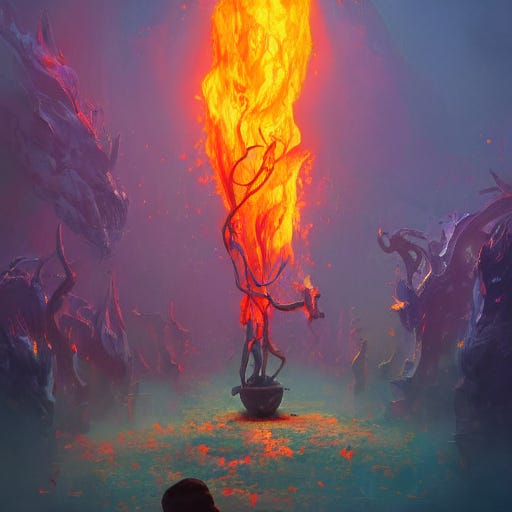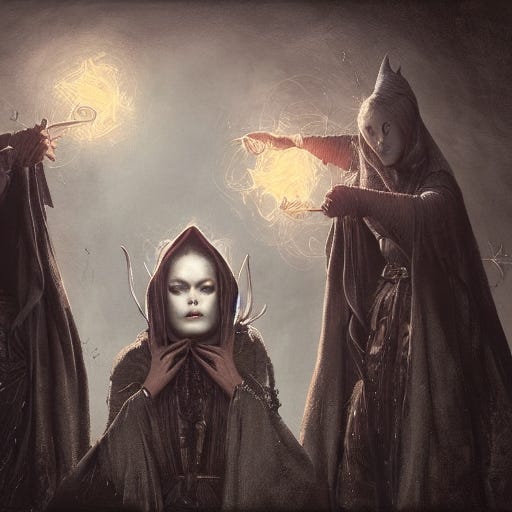In this series I’ll be developing a new system for casting magic in tabletop role-playing games. When complete it will be available at joeyv120.itch.io
Check out Part 1 of this series for a little background on my intent for creating this system. But here’s a summary of the objectives.
Design Pillars
Simplicity: A minimalistic design throughout.
Flexibility: A flexible and dynamic spell-crafting system.
Uncertainty: Magic comes with uncertainty, like rolling dice.
Agency: Players may craft, define, and describe their spells.
Guidance: A set of boundaries within which to navigate.
Consequences: Tools to promote fair play.
Progressive: Support for novice to heroic characters.
Neutrality: Readily applied to any game or setting

Character Interface Layer
The Character Interface Layer (CIL) is what I’m calling it: the stuff that the characters interact with and have in-game knowledge of; the narrative skin that connects the PCs to the system. In Mausritter, this is represented by tangible “runes carved on obsidian tablets”, and Into the Odd similarly has “Arcana” items. Ironsworn uses more abstracted assets called “Rituals” that characters can learn and advance in.
For [interesting and evocative name for this system] I draw inspiration heavily from Witchery, which was itself inspired by the Hermetic magic of Ars Magica. I prefer this more ritualistic and folkloric design to the Vancian magic of early D&D and similar systems, as it feels more realistic (forgetting for a moment that we’re talking about magic). Witchery allows PCs to choose three tags, one from each of three sets of “boons” (Elements, Arts, and Conduits), which combine to form a collection within which they can define different spells. This is the best explanation I could produce in one sentence. As an example, a player might choose Fire (element) - Warding (art) - Brew (conduit) to create a potion of fire resistance. Don’t worry if this still isn’t clear because it doesn’t matter.
Studies
In [clever system name] there are similarly three groups of tags — I’ll refer to as components — which are spheres, fiats, and paths. A combination of specific components is called a Study, and the study determines what spells the caster can craft. Likely, a crafter will start with knowledge of one study and can learn more Studies as they gain advance. I feel like I’ve already missed that “simplicity” design pillar. Anyway…
Studies do not represent a specific spell, but a range of knowledge under which many spells may be cast.

Components
With each of the component tags below I included a brief list of ways the tag could be interpreted. For example, knowledge of the sphere of Air might give the spellcaster power to control wind and weather. These suggested interpretations are neither permissive nor exhaustive.
The 8 spheres represent the elemental target of a spell (the “noun”).
Air – gas, pressure, sound, weather, wind, vapor
Body – ability, appearance, condition, derivatives
Earth – derivatives, glass, metal, stone, water
Flora – behavior, derivatives, disease, poison
Light – color, perception, shadow, visibility
Mind – consciousness, emotion, morale, perception
Pyre – energy, flame, heat, pain, smoke
Wyrd – fate, gravity, spirit, time, undead
Yes, I used “wyrd” as a catch-all for other cool stuff magic can affect. Sorry-not-sorry.
The 5 fiats instruct a spell’s behavior (the “verb”).
Compelling – force, influence
Divining – commune, foreknow
Summoning – create, gather
Transmuting – alter, transform
Warding – banish, protect
The 4 paths are modes in which a spell may be expressed (the “delivery”).
Brew – potion, powder, consumable item
Circle – boundary, drawn, constructed, natural
Ritual – performance, incantation, gesture
Token – poppet, tool, wand, non-consumable object
Examples
A spellcaster has a study in Pyre-Summoning-Tokens. Within that study they could create a wand of fireballs or a flaming sword.
A study in Light-Compelling-Ritual may allow the caster to focus the sun’s rays into a deadly weapon or bend light around themselves to appear invisible. To achieve a similar result, a spellcaster with a study in Mind-Compelling-Ritual can become invisible by casting a charm on the observers.
There is often more than one study to achieve the same result. You are limited only by your creativity, imagination, and the approval of your guide.
The Casting
The path of a study suggests when the spell is cast, and it will influence where the CIL (that bogus acronym I invented earlier) meets the mechanical layer. When I use the word “cast” in this section I explicitly mean both the narrative action of casting a spell, and the IRL rolling of dice to resolve the outcome.
Brews, such as potions, are cast when concocted even if the effect is not realized until the item is consumed. I picture the cliche witch sing-songing over their cauldron — with a dash of newt’s eye — for a desperate customer. Mechanically, I believe it makes sense for each “dose” of a brew to require a separate dice roll.
Circles are cast, or activated, when the character specifies the spell and defines its physical boundary. Like the druid constructing a massive henge, or the wizard marking a door with chalk. In most cases I imagine this as a persistent spell (within reason), that perhaps fades over time.
Rituals are cast when the character performs the action required to activate the spell. This may be a simple vocalization (Wingardium Leviosar!) or a complex dance of writhing naked bodies around an enormous bonfire. Either way, roll them bones.
Tokens are cast when the character imbues an object with a spell. Once this is done the spell can be activated at will by the caster assuming there is at least one “charge” available. Like with Brews, each charge requires a separate dice roll.

Until Next Time
I’ve put a lot of thought into how I want this to work, but I welcome your feedback and constructive criticism as I continue to develop this. Feel free to comment. Otherwise, I hope to see you again soon with Part 3 of this series where I’ll likely get into the mechanics and dice resolution. Cheers!



I think I'll make a graphic to include in my next post to illustrate how this works. Might be easier to understand that way.